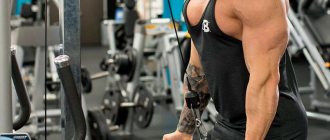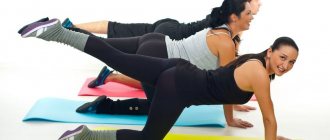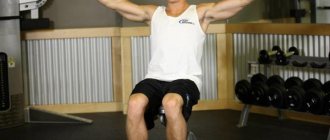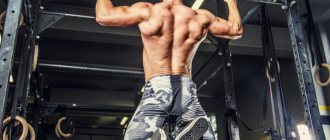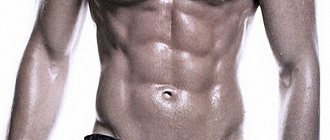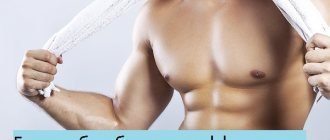Publication date: December 24, 2021.
Arm training is one of the favorite activities of both beginners and professionals. After all, voluminous hands always evoke admiring glances from others.
The overhead dumbbell extension (also known as the French press while seated or standing) is an effective triceps exercise that should definitely be included in your training program.
In terms of the nature of the load, it is close to the French bench press, but it also has significant differences. Each of these two exercises would be a great addition to your arm training program.
Overhead dumbbell extension: muscles that work
In fact, no matter how much I train, only a few people use this exercise, and, as a rule, athletes who have been training for quite a long time.
Many people are unaware of the effectiveness and usefulness of this exercise, especially for developing the long head of the triceps, which usually works indirectly in other triceps exercises.
Let's sort it out in order.
To begin with, I highly recommend that you read my article about the anatomy of the hands. In fact, the article will really help you understand how the triceps works.
This is what the “horseshoe-shaped” triceps brachii muscle looks like, or, as we will call it, triceps.
In principle, nothing complicated.
During the exercise, the triceps anatomy will look like this:
Thanks to the common attachment (ligament) in the elbow area, during the exercise all triceps heads are included in the work at the same time!
Despite this, in different exercises, there is a certain emphasis on the load on one of the heads or two heads.
That is, it seems that all the heads of the triceps work, but to varying degrees.
- The long head of the triceps (internal) is attached to the shoulder blade at the back. Requires maximum abduction of the arm back (ideally, the shoulder joint should also be included in the work, since the long head is involved in its extension).
- Lateral (outer) head of the triceps + medial (middle) head of the triceps - attached to the humerus. Participate only in extension of the forearm. The medial head of the triceps has a long tendon, which is why it has the so-called. depression near the elbow.
Remember when I said that the long head rarely works with emphasis in other exercises? Do you understand why?
Because the long head, as I wrote above, requires maximum abduction of the arm back due to its attachment to the shoulder blade.
That's the whole secret.
In the exercise, arm extension with dumbbells from behind the head, we just move the arm back, you can even help yourself a little with your shoulder in order to better target the long head of the triceps.
I want to say that although our emphasis is on the long head, the other heads also do not go unnoticed.
In general, in principle, when you use this exercise, you will then understand what I’m talking about, you will have a feeling as if your entire triceps is filled with blood, and after a couple of days it will hurt in very unusual places.
What else can you say about this exercise?
- Refers to isolating (one joint works).
- Arnold Schwarzenegger liked to use these arm extensions with one dumbbell for the triceps.
- In addition to the target (targeted) muscle - the triceps, synergistic muscles also work: the anterior delta, pectoralis (pectoral muscle, clavicular head), wrist flexors.
Dumbbell Triceps Extension: Benefits of the Exercise
For myself, I have identified the following advantages from using this exercise for many years:
- triceps works in isolation, the influence of other muscles, if any, is minimal;
- Hands are growing well;
- increasing strength in this exercise;
- excellent pumping;
- the exercise perfectly helps to remove the “jelly” under the hands, which is important for women (this works in combination with a diet, of course);
- increasing shoulder and elbow stability;
- development of functionality, flexibility;
- the ability to pump up triceps at home;
This is the first thing that came to mind, in fact, this is one of my favorite triceps exercises.
Execution technique
- While standing or sitting, take a dumbbell in one hand and lift it above your shoulder.
- Keep your other hand freely or hold your working hand below the elbow if additional support is needed.
- Keeping your elbow close to your head, inhale and lower the dumbbell as far behind your head as possible, stretching your triceps to the maximum.
- Exhale and straighten your elbow.
- Don't tilt your body, keep your abs toned.
- Repeat on the other hand.
Don't try to lift a lot of weight, this exercise is enough to load the triceps with a small weight. The main thing is that on the last reps you feel a burning sensation in your triceps. Perform 14-20 repetitions on each arm for 3-4 sets.
Extension of arms with dumbbells from behind the head: technique of performing the exercise
In fact, the technique of performing the exercise, despite its apparent simplicity, has its own nuances.
If you don’t know how to choose a weight that you will be comfortable with and that will not crush you, then read my article on how to increase working weights in exercises.
I prefer to do this exercise:
- With one dumbbell (holding it with both hands).
- Sitting on a bench with a low back for support.
It was in this form of performing this exercise that I felt the maximum effect for myself in terms of triceps growth.
In the photo below, where I will show the nuances of the technique for performing this exercise, I use a form of performing the exercise without supporting my back, I don’t do this on purpose, it’s just that in that gym in Medgor (where I’m from) there is no bench with a low back.
How to perform overhead dumbbell extensions:
- Starting position: take a dumbbell, sit on a bench (take a bench with a low back, you can use a Scott bench, for example). Raise the dumbbell with both hands above your head, taking it so that the bar of the dumbbell is between your thumbs near your hands, your fingers should form a triangle, and one of the weights rests on your palms), your elbows should be facing inward. Place your feet on the floor, arch your back slightly, and look straight ahead.
- Let's exhale. We keep our shoulders close to the head, leaving our elbows slightly apart. Slowly lower the projectile behind your head until your forearms touch your biceps. As you lower the dumbbell, gently draw air into your lungs. You may notice that the humerus and forearm form an acute angle (not straight, but acute).
- At the lowest point of lowering the dumbbell, feel the point of maximum stretch, adjust the position of your hands, if you don’t feel the triceps working (the load should clearly fall on the triceps), hold at the lowest point for 1-2 seconds. The lungs should already be full of air at this moment.
- With a powerful movement, exhaling, return the dumbbell to its original position, feeling the tension of the triceps at each point of the amplitude.
- At the top point (starting position), make an additional peak contraction of your triceps.
Important features and subtleties of technology
In order to load your triceps much more strongly, you can use the following tricks:
- The elbows are stationary throughout the entire exercise, only the forearms move.
- Do not spread your elbows too far to the sides and do not let them move apart.
- Move slower down, faster up.
- Peak contraction at top, use.
- Maximum stretch at the bottom + pause 1-2 seconds.
- Don't stop between reps, do it without stopping.
- For heavier weights, ask your training partner to give you the weight.
Variations of the exercise
The movement can be adapted to almost any anatomical feature, be it broad shoulders, large hands, insufficient flexibility of the shoulder joint, and the inability to connect the hands on dumbbell discs.
This option is indicated for those who experience discomfort when performing movements on the bar and cannot hold the weight behind their head or bend both arms at the same time due to the large volume of muscles. This option is also suitable for those whose triceps are developed differently, and one hand takes on the entire load.
The exercise technically replicates the single dumbbell variations, but you need to hold two dumbbells and perform the movement in sync.
Some people recommend holding the dumbbells together, but this is not suitable if the reason for choosing this option is a shoulder injury. In this case, the forearms are held parallel to each other.
This option is better suited for those who experience discomfort and are faced with different development of both halves of the body. Those who have one triceps weaker than the other usually perform “one-armed” versions of exercises simply because this allows them to achieve harmonious development. This extension variation is widely used in bodybuilding. You can also perform the exercise by holding one forearm with the opposite hand.
Technically, the movement has its own characteristics - you can bend your arm so that the forearm is perpendicular to the spine, or parallel, but then the shoulder is held with the help of the second hand. Otherwise, the movement resembles the version with one dumbbell - flexion and extension at the elbow joint.
The most important point in all technical variations of the exercise is keeping the elbow and forearm in the same position. If the elbow moves along a trajectory and plane, the athlete performs the exercise incorrectly and takes some of the load off the triceps. Shoulder movement is also not allowed. The elbows should be fixed at one point throughout the exercise.
Options for performing overhead dumbbell extensions
I showed you my favorite and, in my opinion, the most effective form of performing this exercise, but there are also other variations that you can use, for example, for variety or due to anthropometric characteristics (for example, sharp pain when performing the first variation) :
- Extension of two dumbbells from behind the head while sitting.
- Standing arm extension.
- Alternately extend the dumbbell behind the head with each arm while standing or sitting.
- Crossover extension of the arms behind the head.
I see no point in describing the technique of each of these variations, since, in essence, it will be the same.
Exercise options
The main version of the exercise involves performing a bench press with your right and left hands alternately. This method allows you to work out the target muscles as efficiently as possible.
Two-arm French press
In this case, the exercise is not done with the right and left hands alternately, but with both hands at once. To perform this version of the French press, you can use a dumbbell, holding it vertically in the area of the upper plates, or a barbell with a straight or curved bar.
With this method of performing the bench press, the exercise takes half as much time; this option allows you to work with maximum weights, but for most athletes it will not be very convenient and effective.
Seated French press
The seated press can be performed either on a bench with or without a backrest. The first option is preferable, since in this case the back receives support, this takes the load off the spine and makes it possible to concentrate on working the triceps. However, the load on the spinal column is significantly reduced even when performing bench presses without a backrest
French press standing
An important advantage of this option is a large degree of freedom: you can easily move your body to the right, left, forward and backward to find the optimal position for yourself. However, the same can be done on a bench with an adjustable backrest.
At the same time, when performing the exercise while standing, you have to maintain balance in the chosen position, so it is more difficult to concentrate on working the target muscle.
In addition, as noted above, this option involves a significant load on the spine, which is best avoided if possible.
Is this exercise effective for triceps? EMG method
There is a way to determine the electrical activity of a muscle during an exercise; Bret Contreras was the first to do this; after 2015, this is the most accurate way to determine the effectiveness of an exercise.
The method is called electromyography (EMG).
In July 2015, scientists from the Center for Practical Physiology (USA, Tennessee) conducted research that was aimed at identifying the best exercises for each specific human muscle.
For the triceps, the following data were obtained (in descending order from the best exercise):
- Extension of arms with a straight bar lying on a bench at a negative angle – 92%.
- Arm extension on a block (specifically with a V-shaped iron short handle) – 90%.
- Dips – 87%.
- Extension of arms with a dumbbell from behind the head, sitting on a bench – 82%.
The above data suggests that the exercise we are talking about today is in 4th place, but for the long head of the triceps, perhaps, and also in terms of “unusual sensations,” I think, in first place. But this is purely my subjective opinion.
